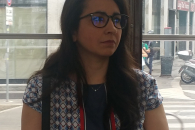L’Axe de recherche « Science des données, transformation digitale, risques et systèmes complexes », avec ses trois sujets distincts mais interconnectés, témoigne des efforts profonds des chercheurs de l’ESILV et de l’EMLV pour contribuer à un monde plus informé et technologiquement avancé.
Le premier point focal, les Systèmes Complexes, est centré sur la modélisation des interactions complexes de diverses entités.
Cela comprend :
Le domaine des Risques se concentre sur les aspects multifacettes des menaces et défis potentiels :
Le troisième segment, Science des Données et Transformation Digitale, est un signe de notre ère numérique en évolution :
L’équipe d’enseignants-chercheurs Science des données, transformation digitale, risques et systèmes complexes
L’ensemble des travaux des enseignants-chercheurs Science des données, transformation digitale, risques et systèmes complexes
Ahmad Makki; RIM MHEICH; Madalina Petcu; Raafat Talhouk
Asymptotic behavior of the coupled Allen-Cahn/Cahn-Hilliard system with proliferation term Article de journal
Dans: Journal Of Mathematical Analysis And Applications, vol. 548, no. 1, p. 129382, 2025.
@article{makki_3409,
title = {Asymptotic behavior of the coupled Allen-Cahn/Cahn-Hilliard system with proliferation term},
author = {Ahmad Makki and RIM MHEICH and Madalina Petcu and Raafat Talhouk},
url = {https://doi.org/10.1016/j.jmaa.2025.129382},
year = {2025},
date = {2025-08-01},
journal = {Journal Of Mathematical Analysis And Applications},
volume = {548},
number = {1},
pages = {129382},
abstract = {In this article, we investigate the coupled Allen-Cahn/Cahn-Hilliard equations with
a proliferation term, which can model the growth of cancerous tumors and other
biological entities. We focus on establishing the existence, uniqueness, and regularity
of solutions, as well as analyzing their asymptotic behavior, with particular attention
to the existence of finite-dimensional attractors. The system is considered under
Dirichlet boundary conditions, and we introduce assumptions on the proliferation
term to ensure dissipativity.},
keywords = {},
pubstate = {published},
tppubtype = {article}
}
Sachin Kumar; Vinod Kumar; Ranjan Chaudhuri; Sheshadri Chatterjee; Demetris Vrontis
AI capability and environmental sustainability performance: Moderating role of green knowledge management Article de journal
Dans: Technology In Society, vol. 81, p. 102870, 2025.
@article{kumar_3606,
title = {AI capability and environmental sustainability performance: Moderating role of green knowledge management},
author = {Sachin Kumar and Vinod Kumar and Ranjan Chaudhuri and Sheshadri Chatterjee and Demetris Vrontis},
url = {http://dx.doi.org/10.1016/j.techsoc.2025.102870},
year = {2025},
date = {2025-06-01},
journal = {Technology In Society},
volume = {81},
pages = {102870},
abstract = {The capabilities of AI may not only foster green technology innovations but also enhance the environmental
sustainability performance of organizations. Despite this, the interplay between AI capabilities, green technology
innovations, and environmental sustainability performance largely remain unexplored in view of green knowledge management. The present study aims to fill this gap by examining the impact of AI capabilities on green
technology innovations and ultimately on environmental sustainability performance. This study also examines
how green technology innovations mediates between AI capabilities and environmental sustainability performance, and how green knowledge management moderates the relationships between AI capabilities and green
technology innovations and between AI capabilities and environmental sustainability performance. To validate
the proposed conceptual relationships, data were collected from IT companies of Pune, India from 237 respondents, and they were validated with PLS-SEM 3.0 software. The results of the present study contribute
theoretically to the resources-based view, knowledge-based view, dynamic capability, and absorptive capacity
theories. Moreover, this study has also contributed practically by revealing the potential of AI capabilities and
green technology innovations to enhance environmental sustainability performance through green knowledge
management. The insights of the study could also help managers to leverage the AI capabilities to enhance green
technology innovations and to improve environmental sustainability performance of organizations.},
keywords = {},
pubstate = {published},
tppubtype = {article}
}
Luc Molinet; Raafat Talhouk
Global solutions for the one-dimensional Boussinesq-Peregrine system under small bottom variation Article de journal
Dans: Journal Of Differential Equations, vol. 423, p. 550-596, 2025.
@article{molinet_3314,
title = {Global solutions for the one-dimensional Boussinesq-Peregrine system under small bottom variation},
author = {Luc Molinet and Raafat Talhouk},
url = {https://www.sciencedirect.com/science/article/abs/pii/S0022039625000129},
year = {2025},
date = {2025-04-01},
journal = {Journal Of Differential Equations},
volume = {423},
pages = {550-596},
abstract = {The Boussinesq-Peregrine system is derived from the water waves system in presence of topographic variation under the hypothesis of shallowness and small amplitude regime. The system becomes significantly simpler (at least in the mathematical sens) under the hypothesis of small topographic variation. In this work we study the long time and global well-posedness of the Boussinesq-Peregrine system. We start by showing the intermediate time well-posedness in the case of general topography (i.e. the amplitude of the bottom graph ?=O(1)). The novelty resides in the functional setting, Hs(R), s>12. Then we show our main result establishing that the global existence result obtained in [14] in the flat bottom case is still valid for the Boussinesq-Peregrine system under the hypothesis of small amplitude bottom variation (i.e. ?=O(?)). More precisely we prove that this system is unconditionally globally well-posed in the Sobolev spaces of type Hs(R), s>12. Finally, we show the existence of a weak global solution in the Schonbek sense [18], i.e. existence of low regularity entropic solutions of the small bottom amplitude BoussinesqPelegrine equations emanating from u0?H1and ?0in an Orlicz class as weak limits of regular solutions.
©2025 Elsevier Inc. All rights are reserved, including those for text and data mining, AI training, and similar technologies.},
keywords = {},
pubstate = {published},
tppubtype = {article}
}
Ni ZHU; Ruiwen He; Zhiqiang Wang
Dans: Engineering Applications Of Artificial Intelligence, vol. 145, p. 110160, 2025.
@article{zhu_3394,
title = {CarNet: A generative convolutional neural network-based line-of-sight/non-line-of-sight classifier for global navigation satellite systems by transforming multivariate time-series data into images},
author = {Ni ZHU and Ruiwen He and Zhiqiang Wang},
url = {https://www.sciencedirect.com/science/article/pii/S0952197625001605?via%3Dihub},
year = {2025},
date = {2025-04-01},
journal = {Engineering Applications Of Artificial Intelligence},
volume = {145},
pages = {110160},
abstract = {Urban environments present significant challenges to commercial Global Navigation Satellite Systems (GNSS) receivers due to degraded satellite visibility and Non-line-of-sight (NLOS) receptions. Mitigating NLOS receptions for GNSS is essential, especially for safety-critical and reliability-critical location-based applications. Traditional physical error channel propagation modeling encountered bottlenecks since the NLOS and multipath errors cannot be modeled accurately in complex urban environments. Data-driven methods show significant potential for effectively classifying GNSS Line-of-sight (LOS) and NLOS. This paper proposes the CarNet - a generative Convolutional Neural Network (CNN)-based GNSS LOS/NLOS classifier by transforming multivariate time-series data into images. CarNet comprises two modules: an image generator and an image classifier. The image generator enriches and augments the original 1-dimension feature vector into 2-dimension feature maps and the image classifier uses an inception-based CNN to realize multi-scale feature extraction and classification. The proposed architecture is trained and tested on more than 6 h of real vehicle data collected in different challenging environments (about 1.6 million samples). A thorough benchmark is conducted, comparing CarNet against the existing mainstream Artificial Intelligence (AI) methods. The results with cross-validation on unseen data indicate that CarNet achieves the highest accuracy, i.e., 81.47% while maintaining the optimal balance between precision for both classes: 83.3% for LOS and 70.99% for NLOS. Finally, positioning accuracy is assessed using a reweighting strategy based on the LOS/NLOS information predicted by CarNet. The assessment of total datasets shows that CarNet weighting can achieve the best accuracy compared to the traditional weighting schemes based on signal-to-noise ratio or satellite elevation. CarNet shows strong potential for embedding into GNSS receivers to enhance positioning accuracy in complex urban environments, benefiting a wide range of location-based applications such as autonomous driving, emergency response, and urban logistics.},
keywords = {},
pubstate = {published},
tppubtype = {article}
}
Zuowei Zhang; Yiru ZHANG; Hongpeng Tian; Arnaud Martin; Zhunga LIU; Weiping Ding
A survey of evidential clustering: Definitions, methods, and applications Article de journal
Dans: Information Fusion, vol. 115, p. 102736, 2025.
@article{zhang_3199,
title = {A survey of evidential clustering: Definitions, methods, and applications},
author = {Zuowei Zhang and Yiru ZHANG and Hongpeng Tian and Arnaud Martin and Zhunga LIU and Weiping Ding},
url = {https://www.sciencedirect.com/science/article/pii/S1566253524005141},
year = {2025},
date = {2025-03-01},
journal = {Information Fusion},
volume = {115},
pages = {102736},
abstract = {In the realm of information fusion, clustering stands out as a common subject and is extensively applied across various fields. Evidential clustering, an increasingly popular method in the soft clustering family, derives its strength from the theory of belief functions, which enables it to effectively characterize the uncertainty and imprecision of data distributions. This survey provides a comprehensive overview of evidential clustering, detailing its theoretical foundations, methodologies, and applications. Specifically, we start by briefly recalling the theory of belief functions with its transformations into other uncertainty reasoning theories. Then, we introduce the concepts of soft data, partitions, and methods with an emphasis on data and partitioning within the theory of belief functions. Subsequently, we summarize the advancements and quantitative evaluations of existing evidential clustering methods and provide a roadmap to help in selecting an appropriate method based on specific application needs. Finally, we identify the major challenges faced in the development and application of evidential clustering, pointing out promising avenues for future research, including theoretical limitations, applicable datasets, and application domains. The survey offers a structured understanding of existing evidential clustering methods, highlighting their theoretical underpinnings, practical implementations, and future research directions. It serves as a valuable resource for researchers seeking to deepen their understanding of evidential clustering.},
keywords = {},
pubstate = {published},
tppubtype = {article}
}
Anouar Obbadi; Mofdi El-Amrani; Mohammed Seaid; Driss Yakoubi
A stable second-order splitting method for incompressible Navier-Stokes equations using the scalar auxiliary variable approach Article de journal
Dans: Computer Methods In Applied Mechanics And Engineering, vol. 437, p. 117801, 2025.
@article{obbadi_3392,
title = {A stable second-order splitting method for incompressible Navier-Stokes equations using the scalar auxiliary variable approach},
author = {Anouar Obbadi and Mofdi El-Amrani and Mohammed Seaid and Driss Yakoubi},
url = {https://www.sciencedirect.com/science/article/pii/S0045782525000738?dgcid=coauthor},
year = {2025},
date = {2025-03-01},
journal = {Computer Methods In Applied Mechanics And Engineering},
volume = {437},
pages = {117801},
abstract = {We propose a novel second-order fractional-step method for the numerical solution of incompressible Navier-Stokes equations. This fractional-step method consists of two splitting steps and it employs the second-order implicit backward differentiation formula for the time integration.
Unlike most of the projection methods for solving incompressible Navier-Stokes equations, the proposed method is free from any numerical inconsistencies generated by the treatment
of boundary conditions on the pressure solution. Two pressure-correction strategies including the scalar auxiliary variable approach are proposed to enhance the accuracy of the method.
A rigorous stability analysis is also carried out in this study for the considered strategies.
Numerical results are presented for three benchmark problems to validate the unconditional stability and to demonstrate the performance of the proposed fractional-step method for solving unsteady incompressible viscous flows. The obtained computational results support our
theoretical expectations for an unconditionally stable second-order fractional-step method for the incompressible Navier-Stokes equations.},
keywords = {},
pubstate = {published},
tppubtype = {article}
}
Kuldeep Singh; Ranjan Chaudhuri; Sheshadri Chatterjee
Assessing the impact of digital transformation on green supply chain for achieving carbon neutrality and accelerating circular economy initiatives Article de journal
Dans: Computers & Industrial Engineering, vol. 201, p. 110943, 2025.
@article{singh_3397,
title = {Assessing the impact of digital transformation on green supply chain for achieving carbon neutrality and accelerating circular economy initiatives},
author = {Kuldeep Singh and Ranjan Chaudhuri and Sheshadri Chatterjee},
url = {https://www.sciencedirect.com/science/article/pii/S0360835225000890?via%3Dihub},
year = {2025},
date = {2025-03-01},
journal = {Computers & Industrial Engineering},
volume = {201},
pages = {110943},
abstract = {The objective of this research is to analyse how digital transformation initiatives influence the effectiveness of green supply chain practices to achieve carbon neutrality as well as to accelerate circular economy practices. The study posits a theoretical model grounded in resource-based, data empowerment, and contingency theory to conduct the study. The main aspect of the research is to analyse the mediating role played by green supply chain integration on the association between digital transformation and green supply chain performance. Furthermore, the study also tried to uncover the moderating impact of absorptive capacity and economic policy uncertainty on above mentioned relationship. The moderating effect could deaccelerate carbon neutrality and could create hindrance towards circular economy. Hence, absorptive capacity is anticipated to influence how organizations assimilate and apply digital advancements, while economic policy uncertainty is expected to shape the overall landscape within which these transformations occur. The study followed a quantitative design and PLS-SEM analysis. The results show the importance of digital transformation in in order to derive environmental sustainability within supply chains. In this study absorptive capacity found as a significant moderator. The results offer valuable insights for businesses in order to to enhance environmental sustainability. Also, these efforts with digital transformation and effective SCM practices can help a firm to achieve carbon neutrality. This distinct approach promotes more sustainable and resilient green supply chain practices that enables businesses to stay agile and accelerate circular economy practices.},
keywords = {},
pubstate = {published},
tppubtype = {article}
}
Laura Recuero Virto; Peter Saba; Arno Thielens; Marek Czerwinski; Paul Noumba Um
Digital Sustainability Trade-Offs: Public Perceptions of Mobile Radiation and Green Roofs Article de journal
Dans: Communications of the AIS, vol. 56, no. 1, 2025.
@article{recuero_virto_3615,
title = {Digital Sustainability Trade-Offs: Public Perceptions of Mobile Radiation and Green Roofs},
author = {Laura Recuero Virto and Peter Saba and Arno Thielens and Marek Czerwinski and Paul Noumba Um},
url = {https://aisel.aisnet.org/cais/vol56/iss1/27/},
year = {2025},
date = {2025-03-01},
journal = {Communications of the AIS},
volume = {56},
number = {1},
abstract = {This paper explores how public perceptions influence the interplay between Digital Sustainability (DS), public health, and environmental policy, particularly regarding the effects of mobile radiation on green roofs. While green roofs are recognized for their ecological advantages, the impact of mobile radiation exposure, especially from 5G technology, has not been thoroughly examined in Information Systems (IS) research. Through a Discrete Choice Experiment (DCE) involving an urban sample from the French population, our findings indicate a significant preference for funding research focused on human health compared to plant health, with willingness to pay (WTP) estimates for human health nearly twice as high. Nonetheless, the considerable support for plant health research underscores the importance of addressing both human and environmental aspects in policy formulation. This study contributes to the growing DS dialogue by demonstrating how cognitive, emotional, and moral perceptions shape public backing for research on mobile radiation. These findings enhance our understanding of how public attitudes influence the adoption and regulation of green technologies in urban environments. Our research provides insights for IS researchers and policymakers, advocating for balanced funding approaches and the integration of cognitive, emotional, and ethical factors into policy frameworks to foster effective public engagement and regulatory policies.},
keywords = {},
pubstate = {accepted},
tppubtype = {article}
}
Sanjay Chaudhary; Amandeep Dhir; Duc Khuong Nguyen; Enrico Battisti; Puneet Kaur
Exploring Family Values, Religion, and Ethical Behavior in Family Businesses: A Multi-Stage Qualitative Investigation Article de journal
Dans: Journal Of Business Ethics, 2025.
@article{chaudhary_3626,
title = {Exploring Family Values, Religion, and Ethical Behavior in Family Businesses: A Multi-Stage Qualitative Investigation},
author = {Sanjay Chaudhary and Amandeep Dhir and Duc Khuong Nguyen and Enrico Battisti and Puneet Kaur},
url = {https://link.springer.com/article/10.1007/s10551-025-05947-5},
year = {2025},
date = {2025-03-01},
journal = {Journal Of Business Ethics},
abstract = {One key element distinguishing family firms from non-family firms is the role of the family's religious beliefs, with growing attention on understanding the fit between religion and family in shaping a business's ethical conduct. A family firm's behavior is embedded in an institutional context, and it is important to understand how multiple institutional logic shapes a
family firm's values and ethical behavior. While scholars agree on the central significance of family values and religion in shaping family firms' values and ethical behavior, a definitive consensus on the influence of family values and religion in confronting ethical challenges and shaping ethical behavior has yet to be reached. We lack a theory explaining how family,
family business, and religion shape a family firm's ethical conduct. We conducted a qualitative study to investigate the role
of family values and religion in shaping a family firm's ethical conduct. The results reveal four themes, namely (a) ethical
challenges faced by family firms, (b) family values shaping ethical behavior, (c) religion providing a rationale for family firms'
ethical decision-making, and (d) outcomes of ethical decision-making. The principal contribution of our study is clarifying
the role of multiple institutional logics in the form of religion and family in explaining ethical behavior. Our findings sugges that the fit between religion, family, and business as an institution guides decision-making, helps family businesses earn a positive reputation in the community by displaying ethical behavior, and develops a positive workplace climate.},
keywords = {},
pubstate = {online},
tppubtype = {article}
}
Vinod Kumar; Sachin Kumar; Ranjan Chaudhuri; Sheshadri Chatterjee; Alkis Thrassou; Georgia Sakka
From insight to impact: Unravelling the dynamics of big data-backed growth hacking Article de journal
Dans: Journal Of Business Research, vol. 188, p. 115083, 2025.
@article{kumar_3251,
title = {From insight to impact: Unravelling the dynamics of big data-backed growth hacking},
author = {Vinod Kumar and Sachin Kumar and Ranjan Chaudhuri and Sheshadri Chatterjee and Alkis Thrassou and Georgia Sakka},
url = {https://www.sciencedirect.com/science/article/pii/S0148296324005873?via%3Dihub},
year = {2025},
date = {2025-02-01},
journal = {Journal Of Business Research},
volume = {188},
pages = {115083},
abstract = {The rise of growth hacking, fuelled by big data analytics, poses a challenge for scholars and executives alike, with
limited research at their intersection. This article aims to fill the knowledge gap by focusing on the integration of
big data analytics and growth hacking. Extant theory suggests that incorporating big data cultivates marketing
ambidexterity, especially when moderated by environmental dynamism. The synergistic interplay between big
data analytics and marketing ambidexterity is postulated to enhance firm marketing capabilities, manifesting
itself as growth hacking. The present study develops a corresponding scale on growth hacking and empirically
validates the proposed theoretical framework. Data have been collected from businesses that have used growth
hacking tactics, regardless of their timeframe or resource investment, in two phases and adhering to requisite
sampling size and techniques. The relationships between all variables were found to be significant except the
impact of firm marketing capabilities on customer regain and maintenance. Environmental dynamism was found
to moderate significantly big data analytics and marketing ambidexterity. This study enriches the growth
hacking literature by shedding light on the intricate relationship between big data analytics and strategic
business growth. The findings are also significant to industry, as they arm executives with new and practicable
knowledge towards harnessing growth hacking strategies and securing a competitive edge.},
keywords = {},
pubstate = {published},
tppubtype = {article}
}
Vinod Kumar; Sachim KUMAR; Ranjan Chaudhuri; Sheshadri Chatterjee; Demetris Vrontis; Saeedeh Rezaee Vessal
Innovation capability and R&D performance of organizations: moderating role of industry-academic knowledge transfer Article de journal
Dans: Journal Of Knowledge Management, vol. 29, no. 3, p. 891-914, 2025.
@article{kumar_3311,
title = {Innovation capability and R&D performance of organizations: moderating role of industry-academic knowledge transfer},
author = {Vinod Kumar and Sachim KUMAR and Ranjan Chaudhuri and Sheshadri Chatterjee and Demetris Vrontis and Saeedeh Rezaee Vessal},
url = {https://www.emerald.com/insight/content/doi/10.1108/jkm-02-2024-0175/full/html},
year = {2025},
date = {2025-02-01},
journal = {Journal Of Knowledge Management},
volume = {29},
number = {3},
pages = {891-914},
abstract = {Purpose
This study aims to examine how an organization's innovation capability could influence research and development (R&D) performance. It also investigates if industry-academic knowledge transfer has a moderating relationship between organizational innovation capability and exploration and exploitative innovation in improving the R&D performance of the organizations.
Design/methodology/approach
Based on the literature and dynamic capability view, a conceptual model was developed and then validated using the partial least squares-structural equation modeling technique considering 387 responses from academicians and industry personnel.
Findings
The study found that industry-academic knowledge transfer has a significant moderating impact toward improving innovation capability, organizations' R&D performance and exploration innovation. However, it has an insignificant moderating impact on improving innovation capability and exploitative innovation.
Practical implications
Organizational innovation capability is characterized by both exploratory and exploitative innovation. Both types of innovation support the R&D performance of an organization. Also, organizations that closely work with academic institutions could gain significant R&D knowledge from academic expertise. This study provides food for thought for the academic community as well as industry policymakers.
Originality/value
There are significant opportunities for academic institutions to gain practical knowledge from industry which can help them to accelerate their R&D activities. However, transferring knowledge between industry and academia has challenges related to intellectual property, patents and so on. Not much research has been conducted in this area. Thus, the proposed research model is unique and adds to the existing literature.
Keywords},
keywords = {},
pubstate = {published},
tppubtype = {article}
}
David Korger; Emanuele Poli; Alessandro Biancalani; Alberto Bottino; Omar Maj; Juvert Njeck Sama
Modulational instability of geodesic-acoustic-mode packets Article de journal
Dans: Plasma Physics And Controlled Fusion, vol. 91, no. 1, p. E17, 2025.
@article{korger_3326,
title = {Modulational instability of geodesic-acoustic-mode packets},
author = {David Korger and Emanuele Poli and Alessandro Biancalani and Alberto Bottino and Omar Maj and Juvert Njeck Sama},
url = {https://doi.org/10.1017/S0022377824001284},
year = {2025},
date = {2025-02-01},
journal = {Plasma Physics And Controlled Fusion},
volume = {91},
number = {1},
pages = {E17},
abstract = {Isolated, undamped geodesic-acoustic-mode (GAM) packets have been demonstrated to
obey a (focusing) nonlinear Schrödinger equation (NLSE) (E. Poli, Phys. Plasmas, 2021).
This equation predicts susceptibility of GAM packets to the modulational instability (MI).
The necessary conditions for this instability are analysed analytically and numerically
using the NLSE model. The predictions of the NLSE are compared with gyrokinetic
simulations performed with the global particle-in-cell code ORB5, where GAM packets
are created from initial perturbations of the axisymmetric radial electric field E r . An
instability of the GAM packets with respect to modulations is observed both in cases in
which an initial perturbation is imposed and when the instability develops spontaneously.
However, significant differences in the dynamics of the small scales are discerned between
the NLSE and gyrokinetic simulations. These discrepancies are mainly due to the radial
dependence of the strength of the nonlinear term, which we do not retain in the solution
of the NLSE, and to the damping of higher radial spectral components k r . The damping
of the high- k r components, which develop as a consequence of the nonlinearity, can be
understood in terms of Landau damping. The influence of the ion Larmor radius ? i as well
as the perturbation wavevector k pert on this effect is studied. For the parameters considered
here the aforementioned damping mechanism hinders the MI process significantly from
developing to its full extent and is strong enough to stabilize some of the (according to the
undamped NLSE model) unstable wavevectors.},
keywords = {},
pubstate = {published},
tppubtype = {article}
}
Kuldeep Singh; Sheshadri Chatterjee; Ranjan Chaudhuri; Demetris Vrontis; Helene Yildiz
Knowledge Management and Organizational Resilience in MSMEs: The Intervening Role of Innovation Orientation Article de journal
Dans: Strategic Change, 2025.
@article{singh_3406,
title = {Knowledge Management and Organizational Resilience in MSMEs: The Intervening Role of Innovation Orientation},
author = {Kuldeep Singh and Sheshadri Chatterjee and Ranjan Chaudhuri and Demetris Vrontis and Helene Yildiz},
url = {https://onlinelibrary.wiley.com/doi/10.1002/jsc.2640},
year = {2025},
date = {2025-02-01},
journal = {Strategic Change},
abstract = {The relationship between knowledge management (KM) and organization performance has been thoroughly studied. However,
there is still a research gap to determine other factors that could influence this relationship. One significant component is innovation,
and we need to consider the size and age of the organization to determine how innovation influences organizational resilience
(OR). A few studies discussed innovation and knowledge management; however, they usually focus on large firms. This
study is based on MSMEs in India. In this study, we analyzed how innovation can link between KM and OR. We examined three
components of KM in our research: knowledge generation (KG), knowledge transfer (KT), and knowledge acquisition (KA). We
obtained responses from 336 respondents who took part in this study. We used PLS-SEM
to analyze the data. The findings indicate
that innovation plays an essential role in establishing a relationship between KM and OR. Firm age is found as a significant
moderating factor of this relationship. It implies that, to be robust, older enterprises in MSMEs should prioritize both KM and
innovation. This study can serve as a useful resource for MSMEs that wish to learn more about the role of innovation in utilizing
KM and OR.},
keywords = {},
pubstate = {online},
tppubtype = {article}
}
Krupa Rai; Antonino Galati; Sheshadri Chatterjee; Ranjan Chaudhuri; Demetris Vrontis; Giuseppina Migliore
Uncorking the psychological factors behind habits and NoLo wine preferences Article de journal
Dans: British Food Journal, 2025.
@article{rai_3452,
title = {Uncorking the psychological factors behind habits and NoLo wine preferences},
author = {Krupa Rai and Antonino Galati and Sheshadri Chatterjee and Ranjan Chaudhuri and Demetris Vrontis and Giuseppina Migliore},
url = {http://dx.doi.org/10.1108/BFJ-10-2024-0998},
year = {2025},
date = {2025-02-01},
journal = {British Food Journal},
abstract = {Purpose - The consumption of no-and low-alcohol (NoLo) wines has emerged as a growing trend among Italian
millennials, reflecting a shift towards healthier and more mindful drinking habits. This paper delves into the
social factors driving this trend, employing the rational of habit theory to provide a comprehensive
understanding of NoLo wines consumption as a social behaviour among Italian millennials.
Design/methodology/approach - The research design comprises symmetrical and asymmetrical approach.
The study employs Cluster and fsQCA to understand the granularities of NoLo wine consumption.
Findings - The present study reveals that young adults are willingness to pay (WTP) more for NoLo wine in
exchange of improved health benefits as a reward. The contrarian observation of relatively consumers with low
average income exhibiting the high willingness to pay more for NoLo wine.
Research limitations/implications - The sample islimitedto Italyand skewed in terms ofNoLowine consumption.
The participants were aware of NoLo wine but did not consume it in the past year. The study identified the
paradoxical stance of low average family income group exhibiting more willingness-to-pay for de-alcoholised wine.
Practical implications - Firstly, young adults are increasingly health-conscious,seeking alternativesto alcohol
that promote well-being and reduce health risks associated with excessive alcohol consumption. Secondly,
mindfulness practices have gained popularity among young adults for altering self-perception, leading to a
preference for beverages that align with mindful consumption and stress reduction. NoLo wine offers a suitable
alternative, providing a similar sensory experience without the intoxicating effects of alcohol.
Social implications - Habit theory, pioneered by James (1890), posits that habits are formed through a three-stage
process: cue,routine and reward.In the context of NoLo wine consumption, cues can include social gatherings, dining
occasions orstressrelieftriggers. The routine involvesthe act of consuming NoLo wine, while the reward stemsfrom
the perceived benefits of this wine, such as reduced alcohol intake, improved health and social acceptance. The
prevalence of NoLo wine consumption among Italian young adults can be attributed to a confluence ofsocialfactors.
Originality/value - The paper attempts to evaluate the contrarian case using fsQCA and the conceptual
configuration of necessary conditions, viz. self-perception, social norms and health-consciousness.},
keywords = {},
pubstate = {online},
tppubtype = {article}
}
Mofdi El-Amrani; Anouar Obbadi; Mohammed Seaid; Driss Yakoubi
A fractional time-stepping method for unsteady thermal convection in non-Newtonian fluids Article de journal
Dans: Communications In Nonlinear Science And Numerical Simulation, vol. 140, no. Part 1, p. 108350, 2025.
@article{el-amrani_3162,
title = {A fractional time-stepping method for unsteady thermal convection in non-Newtonian fluids},
author = {Mofdi El-Amrani and Anouar Obbadi and Mohammed Seaid and Driss Yakoubi},
url = {https://www.sciencedirect.com/science/article/pii/S1007570424005355},
year = {2025},
date = {2025-01-01},
journal = {Communications In Nonlinear Science And Numerical Simulation},
volume = {140},
number = {Part 1},
pages = {108350},
abstract = {We propose a fractional-step method for the numerical solution of unsteady thermal convection in non-Newtonian fluids with temperature-dependent physical parameters. The proposed method is based on a viscosity-splitting approach, and it consists of four uncoupled steps where
the convection and diffusion terms of both velocity and temperature solutions are uncoupled while a viscosity term is kept in the correction step at all times.
This fractional-step method maintains the same boundary conditions imposed in the original problem for the corrected velocity solution, and it eliminates all inconsistencies related to boundary conditions for the
treatment of the pressure solution. In addition, the method is unconditionally stable, and it allows the temperature to be transported by a non-divergence-free velocity field. In this case, we introduce a methodology to handle the subtle temperature convection term in the error analysis
and establish full first-order error estimates for the velocity and the temperature solutions and 1?2-order estimates for the pressure solution in their appropriate norms. Three numerical examples are presented to demonstrate the theoretical results and examine the performance of the proposed method for solving unsteady thermal convection in non-Newtonian fluids. The computational results obtained for the considered examples confirm the convergence, accuracy, and applicability of the proposed time fractional-step method for unsteady thermal convection in non-Newtonian fluids.},
keywords = {},
pubstate = {published},
tppubtype = {article}
}
Soumyadeep PATY; Arindam BISWAS; Sonia Djebali; Guillaume Guérard; Supreeti KAMILYA
IoT-Enabled Methane Monitoring and LSTM-Based Forecasting System for Enhanced Safety in Underground Coal Mining Article de journal
Dans: ACM Transactions on Internet of Things, vol. 6, no. 1, 2025.
@article{paty_3212,
title = {IoT-Enabled Methane Monitoring and LSTM-Based Forecasting System for Enhanced Safety in Underground Coal Mining},
author = {Soumyadeep PATY and Arindam BISWAS and Sonia Djebali and Guillaume Guérard and Supreeti KAMILYA},
url = {https://dl.acm.org/doi/pdf/10.1145/3703460},
year = {2025},
date = {2025-01-01},
journal = {ACM Transactions on Internet of Things},
volume = {6},
number = {1},
abstract = {Ensuring safety in the mining industry is a critical concern for a nation's industrial advancement. Industry 4.0, characterized by the integration of advanced technologies, is at the forefront of efforts to enhance mining practices. Coal seams contain a range of
hydrocarbon gases, predominantly methane, which is released in significant quantities during mining operations. Effectively
mitigating methane emissions is imperative. The inclusion of methane forecasting allows for the early identification of potential methane emissions, hence results in significance enhancement in mine safety. The research work is focused on real-time remote monitoring and cloud-based forecasting of methane levels in underground coal mines. An Industrial Internet of Things (IIoT) device is developed for data acquisition in underground coal mines, capturing essential parameters such as methane concentration,
temperature, and humidity. The collected data are utilized to train LSTM based multivariate forecasting model. The trained model is
subsequently deployed in the cloud. The experiment is performed in a mine of Eastern Coalfields Limited, India. After the deployment
of the proposed model, the developed IIoT device transmits real-time data, obtained from the mine, to the cloud. Based on the real
time data, our model conducts methane forecasting and communicates results back to the IIoT device. The device issues immediate
alerts when methane levels surpass predefined thresholds. This ensures enhanced safety in mining operations by providing warnings
for both current and forecasted methane concentrations. The forecasted methane concentrations, along with real-time data, are
accessible through mobile applications and a web-based dashboard. The accuracy of the proposed model is measured by mean
absolute error, mean absolute percentage error and root mean square error, which demonstrate values of 156.95 ppm, 4.23% and
191.53 ppm respectively. A comparative study is performed where our model is evaluated against the multivariate Multilayer
Perceptron (MLP), Vector autoregression (VAR) and Auto-Regressive Integrated Moving Average (ARIMA) models. The comparative
study demonstrates that our developed model outperforms the others, showing superior results.},
keywords = {},
pubstate = {published},
tppubtype = {article}
}
Wissal Benjira; Faten Atigui; Benedicte Bucher; Malika Grim-Yefsah; Nicolas Travers
Automated mapping between SDG indicators and open data: An LLM-augmented knowledge graph approach Article de journal
Dans: Data & Knowledge Engineering, p. 102405, 2025.
@article{benjira_3275,
title = {Automated mapping between SDG indicators and open data: An LLM-augmented knowledge graph approach},
author = {Wissal Benjira and Faten Atigui and Benedicte Bucher and Malika Grim-Yefsah and Nicolas Travers},
url = {https://www.sciencedirect.com/science/article/pii/S0169023X24001290},
year = {2025},
date = {2025-01-01},
journal = {Data & Knowledge Engineering},
pages = {102405},
abstract = {Meeting the Sustainable Development Goals (SDGs) presents a large-scale challenge for all countries. SDGs established by the United Nations provide a comprehensive framework for addressing global issues. To monitor progress towards these goals, we need to develop key performance indicators and integrate and analyze heterogeneous datasets. The definition of these indicators requires the use of existing data and metadata. However, the diversity of data sources and formats raises major issues in terms of structuring and integration. Despite the abundance of open data and metadata, its exploitation remains limited, leaving untapped potential for guiding urban policies towards sustainability. Thus, this paper introduces a novel approach for SDG indicator computation, leveraging the capabilities of Large Language Models (LLMs) and Knowledge Graphs (KGs). We propose a method that combines rule-based filtering with LLM-powered schema mapping to establish semantic correspondences between diverse data sources and SDG indicators, including disaggregation. Our approach integrates these mappings into a KG, which enables indicator computation by querying graph's topology. We evaluate our method through a case study focusing on the SDG Indicator 11.7.1 about accessibility of public open spaces. Our experimental results show significant improvements in accuracy, precision, recall, and F1-score compared to traditional schema mapping techniques.},
keywords = {},
pubstate = {online},
tppubtype = {article}
}
Alain Ghizzo; Daniele Del Sarto; Juvert Njeck Sama; Alessandro Biancalani
Internal transport barrier triggered by phase synchronization of zonal flow with energetic particle modes Article de journal
Dans: Plasma Physics And Controlled Fusion, vol. 67, no. 1, p. 015016, 2025.
@article{ghizzo_3325,
title = {Internal transport barrier triggered by phase synchronization of zonal flow with energetic particle modes},
author = {Alain Ghizzo and Daniele Del Sarto and Juvert Njeck Sama and Alessandro Biancalani},
url = {https://doi.org/10.1088/1361-6587/ad9be6},
year = {2025},
date = {2025-01-01},
journal = {Plasma Physics And Controlled Fusion},
volume = {67},
number = {1},
pages = {015016},
abstract = {The suppression of the microturbulence associated to the emergence of a spontaneous internal transport barrier has been recently demonstrated in a system showing a possible amplification of the zonal flow component in the low-frequency regime (Ghizzo and Del Sarto 2023 Nucl. Fusion 63 104002). We use here numerical experiments performed with a 'particles modes' model based on a double average over the fast cyclotron phase and over the bounce (or transit) phase to show the major role played by energetic particles and shear flows in this scenario. 'Particle modes' are meant here as classes of particles, identified by some adiabatic invariant after a gyro-average procedure, which are associated to the description of some specific linear modes of the plasma. The introduction of energetic circulating ions or shear flows into the system makes a larger number of particle modes being involved in the synchronization process. A global synchronization of the Fourier modes of the turbulent spectrum can be this way achieved. This process allows for a bifurcation towards self-organization, which is associated to the emergence of a staircase-like structure. This is known to be an essential element in the modification of the zonal flow pattern in phase space during the suppression of microturbulence in tokamaks.},
keywords = {},
pubstate = {published},
tppubtype = {article}
}
Christophe Rodrigues; Marius Ortega; Aurélien Bossard; Nédra Mellouli
REDIRE: Extreme REduction DImension for extRactivE Summarization Article de journal
Dans: Data & Knowledge Engineering, vol. 157, p. 102407, 2025.
@article{rodrigues_3621,
title = {REDIRE: Extreme REduction DImension for extRactivE Summarization},
author = {Christophe Rodrigues and Marius Ortega and Aurélien Bossard and Nédra Mellouli},
url = {http://dx.doi.org/10.1016/j.datak.2025.102407},
year = {2025},
date = {2025-01-01},
journal = {Data & Knowledge Engineering},
volume = {157},
pages = {102407},
abstract = {This paper presents an automatic unsupervised summarization model capable of extracting the most important sentences from a corpus. The unsupervised aspect makes it possible to do away
with large corpora, made up of documents and their reference summaries, and to directly process documents potentially made up of several thousand words. To extract sentences in a summary, we use pre-entrained word embeddings to represent the documents. From this thick cloud of word vectors, we apply an extreme dimension reduction to identify important words, which we group by proximity. Sentences are extracted using linear constraint solving
to maximize the information present in the summary. We evaluate the approach on large documents and present very encouraging initial results.},
keywords = {},
pubstate = {published},
tppubtype = {article}
}
Dao Ha; Phuong Le; Duc Khuong Nguyen
Financial inclusion and fintech: a state-of-the-art systematic literature review Article de journal
Dans: Financial Innovation, vol. 11, 69, 2025.
@article{ha_3625,
title = {Financial inclusion and fintech: a state-of-the-art systematic literature review},
author = {Dao Ha and Phuong Le and Duc Khuong Nguyen},
url = {https://jfin-swufe.springeropen.com/articles/10.1186/s40854-024-00741-0},
year = {2025},
date = {2025-01-01},
journal = {Financial Innovation},
volume = {11, 69},
abstract = {This study presents an all-inclusive analysis of the literature on the augmentation
of financial inclusion through fintech. Ninety-six papers were selected from the 2951
articles in the Web of Science, Scopus, and EBSCO databases. This study uses bibliometric
and content analysis techniques to illuminate the underexplored aspects of fintech's
impact on financial inclusion. Unlike previous studies, this study consolidates a significant
amount of the literature on financial inclusion by systematically contextualizing
theories and viewpoints from the fintech sector. The key findings include the identification
of three main research clusters: (1) the advent of novel services, (2) the transformation
of the market landscape, and (3) the roles of stakeholders in the fintech
ecosystem. The analysis reveals gaps in the existing research, such as the need for more
studies on the tangible impact of fintech on financial inclusion and regulation. This
study concludes by highlighting potential directions for future research and emphasizing
the importance of policymakers paying greater attention to fintech's implications
for financial inclusion.},
keywords = {},
pubstate = {online},
tppubtype = {article}
}
Thanh Ngo; Duc Khuong Nguyen; Dinh-Tri Vo
Revisit the First 60 Days of COVID-19: Assessment of the Global Healthcare Systems using Data Envelopment Analysis Article de journal
Dans: 2025.
@article{ngo_3627,
title = {Revisit the First 60 Days of COVID-19: Assessment of the Global Healthcare Systems using Data Envelopment Analysis},
author = {Thanh Ngo and Duc Khuong Nguyen and Dinh-Tri Vo},
url = {http://dx.doi.org/10.1177/09720634241312029},
year = {2025},
date = {2025-01-01},
abstract = {The ongoing pandemic of the novel coronavirus (COVID-19) has exploded and raised important questions on the efficiency
and effectiveness of healthcare systems around the world to provide guidance for appropriate policy responses. While it is
important to look at the current (and future) situation, it is also needed to look back into the past, especially at the first few
months of the pandemic. This study re-examines the efficiency of healthcare systems around the world against the outbreak
of COVID-19 in its first 62 days (23 January 2020-25 March 2020) to see if the examined countries were well prepared
and well reacted to the pandemic. Results from a data envelopment analysis evaluation indicated that the global healthcare
systems experienced a very low efficiency on average. Besides the absence of a coronavirus vaccine at that time, this low efficiency
is typically linked to the operational scale of the healthcare systems, suggesting that countries could tightly rationalise
their healthcare resources/inputs to improve the technical efficiency of their healthcare systems.},
keywords = {},
pubstate = {online},
tppubtype = {article}
}
Insaf Khelladi; Hajer Kefi; Nathalie Veg-Sala; Zied Mani
Les chatbots émotionnels alimentés par l'IA, entre remèdes émotionnels et mirages affectifs Divers
The Conversation, 2025.
@misc{khelladi_3395,
title = {Les chatbots émotionnels alimentés par l'IA, entre remèdes émotionnels et mirages affectifs},
author = {Insaf Khelladi and Hajer Kefi and Nathalie Veg-Sala and Zied Mani},
url = {https://theconversation.com/les-chatbots-emotionnels-alimentes-par-lia-entre-remedes-emotionnels-et-mirages-affectifs-247923},
year = {2025},
date = {2025-02-01},
howpublished = {The Conversation},
note = {https://theconversation.com/les-chatbots-emotionnels-alimentes-par-lia-entre-remedes-emotionnels-et-mirages-affectifs-247923},
keywords = {},
pubstate = {published},
tppubtype = {misc}
}
Insaf Khelladi; Hajer Kefi; Nathalie Veg-Sala; Zied Mani
Les chatbots émotionnels alimentés par l'IA, entre remèdes émotionnels et mirages affectifs Divers
The Conversation, 2025.
@misc{khelladi_3436,
title = {Les chatbots émotionnels alimentés par l'IA, entre remèdes émotionnels et mirages affectifs},
author = {Insaf Khelladi and Hajer Kefi and Nathalie Veg-Sala and Zied Mani},
url = {https://theconversation.com/les-chatbots-emotionnels-alimentes-par-lia-entre-remedes-emotionnels-et-mirages-affectifs-247923},
year = {2025},
date = {2025-02-01},
howpublished = {The Conversation},
keywords = {},
pubstate = {published},
tppubtype = {misc}
}
Erik Ernesto Vazquez Hernandez
How image quality and style of reviews impact purchase behavior in social commerce? Divers
FNEGE Médias, Video, 2025.
@misc{vazquez_hernandez_3438,
title = {How image quality and style of reviews impact purchase behavior in social commerce?},
author = {Erik Ernesto Vazquez Hernandez},
url = {FNEGE medias : https://fnege-medias.fr/fnege-video/how-image-quality-and-style-of-reviews-impact-purchase-behavior-in-social-commerce/
Youtube : https://www.youtube.com/watch?v=5tXC8uEzPkQ},
year = {2025},
date = {2025-02-01},
howpublished = {FNEGE Médias, Video},
note = {mage quality and type of review framing significantly influence purchase intentions on social commerce platforms. High-quality images and personal experience-based reviews enhance mental imagery vividness, leading to increased cognitive and affective social presence. Consequently, consumers are more likely to make a purchase. This research provides valuable insights for businesses to optimize their social commerce strategies by leveraging visual appeal and authentic customer experiences.},
keywords = {},
pubstate = {published},
tppubtype = {misc}
}
Elissar Toufaily
Web3's Missing Pieces: What's Preventing Mass Adoption? Divers
Medium, 2025.
@misc{toufaily_3443,
title = {Web3's Missing Pieces: What's Preventing Mass Adoption?},
author = {Elissar Toufaily},
url = {https://medium.com/@toufaily.elissar/web3s-missing-pieces-what-s-preventing-mass-adoption-a4fbd85da969},
year = {2025},
date = {2025-02-01},
howpublished = {Medium},
keywords = {},
pubstate = {published},
tppubtype = {misc}
}
Erik Ernesto Vazquez Hernandez
How image quality and style of reviews impact purchase behavior in social commerce? Divers
FNEGE Médias, Podcast, 2025.
@misc{vazquez_hernandez_3468,
title = {How image quality and style of reviews impact purchase behavior in social commerce?},
author = {Erik Ernesto Vazquez Hernandez},
url = {FNEGE Médias : https://fnege-medias.fr/podcast/how-image-quality-and-style-of-reviews-impact-purchase-behavior-in-social-commerce/
Apple Podcasts :
Spotify},
year = {2025},
date = {2025-02-01},
howpublished = {FNEGE Médias, Podcast},
note = {Image quality and type of review framing significantly influence purchase intentions on social commerce platforms. High-quality images and personal experience-based reviews enhance mental imagery vividness, leading to increased cognitive and affective social presence. Consequently, consumers are more likely to make a purchase. This research provides valuable insights for businesses to optimize their social commerce strategies by leveraging visual appeal and authentic customer experiences.},
keywords = {},
pubstate = {published},
tppubtype = {misc}
}
Farid Gasmi; Paul Noumba Um; Laura Recuero Virto; Peter Saba
Digital Literacy, Sustainable Development and Radiation Regulation: Policy and Information Systems Implications Article de journal
Dans: Information Systems Frontiers, vol. 26, p. 2027-2057, 2024.
@article{gasmi_2968,
title = {Digital Literacy, Sustainable Development and Radiation Regulation: Policy and Information Systems Implications},
author = {Farid Gasmi and Paul Noumba Um and Laura Recuero Virto and Peter Saba},
url = {https://link.springer.com/article/10.1007/s10796-024-10488-9#citeas},
year = {2024},
date = {2024-12-01},
journal = {Information Systems Frontiers},
volume = {26},
pages = {2027-2057},
abstract = {This paper explores the convergence of development economics, regulatory policies, and public health considerations within the field of Information Systems (IS) research, focusing specifically on 5G and 6G mobile technologies. Despite the widespread deployment of these technologies and their potential health implications, there is a limited understanding in IS literature on why countries adopt varying thresholds for radiation regulation. Our study, analyzing data from 124 countries, uncovered an inverted U-shaped relationship between digital literacy and the rigidity of radiation regulation. This finding reveals that nations with lower digital literacy levels tend to enforce stricter regulations, whereas those with higher literacy levels adopt more relaxed policies. By highlighting how digital literacy, a critical aspect of the digital divide, significantly influences regulatory frameworks in telecommunications, this study contributes to filling the gap in IS research. This under- scores the necessity of informed and transparent regulatory decision making, especially in countries with diverse levels of digital literacy. Calling for a multidisciplinary approach to policy formulation, our work enriches the broader discourse in IS research, underlining the pivotal role of digital literacy in shaping both the access and regulatory landscapes of emerging technologies.},
keywords = {},
pubstate = {published},
tppubtype = {article}
}
Tatiana ZALAN; Elissar Toufaily
A nascent market for digital assets: Exploration of consumer value of NFTs Article de journal
Dans: Digital Business, vol. 4, no. 2, p. 100084, 2024.
@article{zalan_3108,
title = {A nascent market for digital assets: Exploration of consumer value of NFTs},
author = {Tatiana ZALAN and Elissar Toufaily},
url = {https://www.sciencedirect.com/science/article/pii/S2666954424000127?via%3Dihub},
year = {2024},
date = {2024-12-01},
journal = {Digital Business},
volume = {4},
number = {2},
pages = {100084},
abstract = {Despite widespread academic and practitioner interest in non-fungible tokens (NFTs) as a form of digital assets, little is known about how consumers perceive NFT value. This exploratory research investigates why people create, trade or collect NFTs, what value they derive from them, and how online communities contribute to value co-creation. Over the course of two rounds, we interview 38 participants, most of whom are digital natives. We find that engaging with NFTs is the new form of day trading, reflecting financialization of everyday life. The value of NFTs is mainly speculative and utilitarian, and NFTs themselves are best thought of as derivatives. Value co-creation in NFT project communities is largely focused on gaining superior information about the project. We contribute to the crypto-marketing and web3 literature by advancing a novel model of NFT consumer value that extends Holbrook's (1999) typology and distinguishes both positive and negative aspects of consumer value that have been overlooked in mainstream literature. We shed light on the role of communities in an unusual setting: a nascent, illiquid, speculative, informationally opaque market for digital assets. Our study helps creators and brand managers to develop effective NFT strategies.},
keywords = {},
pubstate = {published},
tppubtype = {article}
}
Akram Hakiri; Sadok Ben Yahia; Aniruddha GOKHALE; Nédra Mellouli
Special Issue on Digital Twin for Future Networks and Emerging IoT Applications Article de journal
Dans: Future Generation Computer Systems-The International Journal Of Escience, vol. 161, p. 81-84, 2024.
@article{hakiri_3112,
title = {Special Issue on Digital Twin for Future Networks and Emerging IoT Applications},
author = {Akram Hakiri and Sadok Ben Yahia and Aniruddha GOKHALE and Nédra Mellouli},
url = {https://www.sciencedirect.com/special-issue/10FFXQK3NWS},
year = {2024},
date = {2024-12-01},
journal = {Future Generation Computer Systems-The International Journal Of Escience},
volume = {161},
pages = {81-84},
abstract = {The rapid evolution of digital technologies has given rise to the concept of Digital Twin, a dynamic, virtual representation of physical systems, processes, and environments. This special issue delves into the transformative potential of Digital Twins in the realm of future networks and emerging Internet of Things (IoT) applications. By integrating advanced simulation, real-time data analytics, and machine learning, Digital Twins offer unprecedented opportunities for optimizing network performance, enhancing predictive maintenance, and enabling smarter IoT solutions.
The articles in this issue explore a variety of topics, including the development and implementation of Digital Twins for next-generation communication networks, the role of artificial intelligence in enhancing the fidelity and utility of Digital Twins, and the application of these technologies in diverse IoT domains such as smart cities, healthcare, industrial automation, and environmental monitoring. Emphasis is placed on innovative methodologies, case studies, and experimental results that highlight the practical benefits and challenges associated with deploying Digital Twins in real-world scenarios.
Through this special issue, we aim to provide a comprehensive overview of the current state of research and development in Digital Twins, underscore the technological advancements driving their adoption, and discuss future directions and open research questions. This collection of works serves as a valuable resource for researchers, practitioners, and policymakers interested in harnessing the power of Digital Twins to revolutionize network infrastructures and IoT ecosystems.},
note = {Numéro spécial dans le journal Future Generation Computer Systems},
keywords = {},
pubstate = {published},
tppubtype = {article}
}
Marco A. Fontelos; Nastassia Pouradier Duteil; Francesco Salvarani
Self-similar solutions, regularity and time asymptotics for a nonlinear diffusion equation arising in game theory Article de journal
Dans: Nonlinear Analysis-Real World Applications, vol. 80, p. 104152, 2024.
@article{fontelos_3145,
title = {Self-similar solutions, regularity and time asymptotics for a nonlinear diffusion equation arising in game theory},
author = {Marco A. Fontelos and Nastassia Pouradier Duteil and Francesco Salvarani},
url = {https://www.sciencedirect.com/science/article/abs/pii/S1468121824000920},
year = {2024},
date = {2024-12-01},
journal = {Nonlinear Analysis-Real World Applications},
volume = {80},
pages = {104152},
abstract = {In this article, we study the long-time asymptotic properties of a non-linear and non-local equation of diffusive type which describes the rock-paper-scissors game in an interconnected population. We fully characterize the self-similar solution and then prove that the solution of the initial-boundary value problem converges to the self-similar profile with an algebraic rate.},
keywords = {},
pubstate = {published},
tppubtype = {article}
}
Jean Deteix; Driss Yakoubi
An iterative split scheme for steady flows with heterogeneous viscosity Article de journal
Dans: Computer Methods In Applied Mechanics And Engineering, vol. 423, no. Part A, p. 117391, 2024.
@article{deteix_3161,
title = {An iterative split scheme for steady flows with heterogeneous viscosity},
author = {Jean Deteix and Driss Yakoubi},
url = {https://www.sciencedirect.com/science/article/pii/S0045782524006467},
year = {2024},
date = {2024-12-01},
journal = {Computer Methods In Applied Mechanics And Engineering},
volume = {423},
number = {Part A},
pages = {117391},
abstract = {This paper proposes a numerical scheme for the approximation of the solution of the Stokes or steady Navier-Stokes system for fluids with heterogeneous viscosity (generic bounded viscosity or shear thinning fluids). The scheme is based on a velocity-pressure splitting resembling
a Uzawa approach combined with a grad-div stabilizing term. We establish the validity, convergence and a priori estimates for this strategy. A simpler mixed approach is also presented and studied. Numerical tests using a manufactured solution are provided, giving estimates for the accuracy order and sensitivity to the stabilizing coefficient. For more realistic numerical
experiments, we present results for the lid-driven cavity.},
keywords = {},
pubstate = {published},
tppubtype = {article}
}
Ahmed Ja; Saad Benjelloun; Jean Michel Ghidaglia; Faical Ait Lahbib
Dynamic fluid flow model for phosphate slurry pipeline: OCP main pipeline as case study Article de journal
Dans: International Journal Of Multiphase Flow, vol. 181, p. 105011, 2024.
@article{ja_3172,
title = {Dynamic fluid flow model for phosphate slurry pipeline: OCP main pipeline as case study},
author = {Ahmed Ja and Saad Benjelloun and Jean Michel Ghidaglia and Faical Ait Lahbib},
url = {https://www.sciencedirect.com/science/article/abs/pii/S030193222400288X},
year = {2024},
date = {2024-12-01},
journal = {International Journal Of Multiphase Flow},
volume = {181},
pages = {105011},
abstract = {The transportation of phosphate slurry through large-scale pipelines presents significant challenges due to the complex behavior of multiphase flows, particularly with varying solid content, density, and dynamic viscosity. Efficient and accurate prediction of flow behavior is critical for optimizing the operation of such pipelines. This work aims to develop a dynamic computational model to simulate phosphate slurry flow in pipelines. The case study focuses on the OCP Group's main slurry pipeline, which links the mining sites at Khouribga to the industrial plants at Jorf Lasfar, Morocco. This pipeline system spans a total length of 187.124 km, consisting of 5237 pipes with an inner diameter ranging from 0.8546 m to 0.8578 m, and features several elevation changes along its ground level. Using a section-averaged, dynamic approach and the Finite Volume scheme, the model computes essential flow parameters, including density, dynamic viscosity, and pressure, for the incompressible and non-Newtonian slurry and process water flows. The model's accuracy is validated against on-site measured data, showing an average deviation of ±0.32% for outlet density, and below 10% for pressure along the pipeline, underscoring the model's reliability. Additionally, a sensitivity analysis was conducted to illustrate the impact of key parameters on the predicted head losses and pressures along the pipeline. This analysis shows that the slurry viscosity is the most critical parameter, significantly influencing these predictions. This model provides high accuracy and reasonable CPU time for real-time simulation and monitoring, while also offering significant potential for optimizing pipeline operations and ensuring the reliability of phosphate transport.},
keywords = {},
pubstate = {published},
tppubtype = {article}
}
Najid Ahmad; Duc Khuong Nguyen; Xian-Liang Tian
Assessing the impact of the sharing economy and technological innovation on sustainable development: An empirical investigation of the United Kingdom Article de journal
Dans: Technological Forecasting And Social Change, vol. 209, p. 123743, 2024.
@article{ahmad_3183,
title = {Assessing the impact of the sharing economy and technological innovation on sustainable development: An empirical investigation of the United Kingdom},
author = {Najid Ahmad and Duc Khuong Nguyen and Xian-Liang Tian},
url = {https://www.sciencedirect.com/science/article/pii/S0040162524005419?dgcid=coauthor},
year = {2024},
date = {2024-12-01},
journal = {Technological Forecasting And Social Change},
volume = {209},
pages = {123743},
abstract = {This study adds to the existing literature on the sharing economy by critically evaluating its macro-level impacts and those of technological innovation on sustainability in the United Kingdom, where more than 60% of the population participates in the sharing economy activities. We apply the autoregressive distributed lags model and fully modified ordinary least squares approach to examine 37 years of historical data and elicit robust findings. Our main results are threefold. First, while an initial rise in the sharing economy does not lead to short-run changes in sustainable development, its impact becomes positive in the long run and advances sustainable development. Second, sustainable development is a long-term process to which technological innovation positively contributes, irrespective of the short or long run. Third, domestic and foreign investors positively contribute to sustainability, while economic growth has an inverted U-shape relation with sustainable development. These findings thus suggest that the sharing economy and innovation help boost real-world development and promote a circular economy.},
keywords = {},
pubstate = {published},
tppubtype = {article}
}
Hajer Kefi; Insaf Khelladi; Zied Mani; Nathalie Veg-Sala
AI-enabled social support chatbot usage: flowing ambivalence and liminalities Article de journal
Dans: Journal of Decision Systems, p. 1-24, 2024.
@article{kefi_3254,
title = {AI-enabled social support chatbot usage: flowing ambivalence and liminalities},
author = {Hajer Kefi and Insaf Khelladi and Zied Mani and Nathalie Veg-Sala},
url = {https://www.tandfonline.com/doi/full/10.1080/12460125.2024.2443226},
year = {2024},
date = {2024-12-01},
journal = {Journal of Decision Systems},
pages = {1-24},
abstract = {Interest in social and emotional support chatbots has recently surged, making human - chatbot relationships increasingly common. However, users' subjective experiences with these chatbots often extend beyond simple interactions, reflecting the complex dynamics of liminality and ambivalence. Through a netnographic study of the chatbot Replika, we explore how users experience relational liminality, and control and agency liminality. These dynamics contribute to what we term flowing ambivalence, where users feel both comforted and unsettled, fostering dependency on chatbots despite an awareness of their artificial empathy. Our findings suggest that emotional support chatbots provoke complex emotional states that fluctuate and adapt, underscoring the need for nuanced frameworks to understand how users relate to AI tools.},
keywords = {},
pubstate = {online},
tppubtype = {article}
}
Krupa Rai; Ranjan Chaudhuri; Sheshadri Chatterjee; Demetris Vrontis; Antonino Galati
Digital innovation and automation of business processes using quick response code: advancing the means-end chain theory Article de journal
Dans: Business Process Management Journal, 2024.
@article{rai_3308,
title = {Digital innovation and automation of business processes using quick response code: advancing the means-end chain theory},
author = {Krupa Rai and Ranjan Chaudhuri and Sheshadri Chatterjee and Demetris Vrontis and Antonino Galati},
url = {https://www.emerald.com/insight/content/doi/10.1108/bpmj-05-2024-0339/full/html},
year = {2024},
date = {2024-12-01},
journal = {Business Process Management Journal},
abstract = {Purpose - The purpose of the research is to investigate customer shopping behaviour for Italian market, extra
virgin olive oil (EVOO) using the quick response (QR) code. The study uses means-end chain (MEC) theory to
explore the connections between product attributes, personal values and consumer preferences.
Design/methodology/approach - The theory of means-end chain helps to uncover the underlying reasons why
consumers choose specific products by examining the links between tangibles. There is a conceptual model
developed with the help of MEC. The conceptual framework comprises product information and marketing
communication, which constitute the sensory and non-sensory aspects of consumption behaviour, and it is
empirically tested by CB-SEM technique. QR code usefulness and loyalty are treated as mediators to evaluate
shopping behaviour to purchase EVOO.
Findings - The study has used MEC theory and has extended this theory. This study found that there is a
profound impact of technology (QR code) on the buying behaviour of EVOO for the Italian customers. This
study has also found that product information and product communication play a critical role towards shopping
behaviour of Italian consumers regarding EVOO related products.
Research limitations/implications - Innovation and technology adoption, especially the use of QR codes in
understanding product features, has been an attractive area for research exploration. This could include details
about the product's origin, production methods and nutritional information. Such technology and innovation can change the business process management landscape of food-product distribution process. Not many studies are
available which examine customers' interest and shopping behaviour using QR codes, especially in the context
of EVOO. Thus, this research study has a profound impact on the Italian and other European market.
Originality/value - In the Italian market, EVOO is more than just a product, it is a symbol of tradition, quality
and cultural heritage. EVOO is not just a condiment, it is an essential ingredient that contributes to the overall
flavour of dishes. This study explores the usage of QR code for EVOO related products. This is a unique study as
there are a very few research studies available in this area of business process management and technology usage
related to EVOO products. Moreover, this research study adds values to the body of literature of business process
management, technology usage, innovation and food technology. Thus, this study is unique and adds value to the
existing literature.},
keywords = {},
pubstate = {online},
tppubtype = {article}
}
Laurent Boudin; Alex Rossi; Francesco Salvarani
A kinetic model of polyatomic gas with resonant collisions Article de journal
Dans: Ricerche Di Matematica, vol. 73, p. 2411-2424, 2024.
@article{boudin_1894,
title = {A kinetic model of polyatomic gas with resonant collisions},
author = {Laurent Boudin and Alex Rossi and Francesco Salvarani},
url = {https://doi.org/10.1007/s11587-022-00733-1},
year = {2024},
date = {2024-11-01},
journal = {Ricerche Di Matematica},
volume = {73},
pages = {2411-2424},
keywords = {},
pubstate = {published},
tppubtype = {article}
}
Sheshadri Chatterjee; Ranjan Chaudhuri; Demetris Vrontis; Raj Mahto
Bright and dark sides of adopting a platform-based sharing economy business model Article de journal
Dans: R&D Management, vol. 54, no. 5, p. 1145-1165, 2024.
@article{chatterjee_2917,
title = {Bright and dark sides of adopting a platform-based sharing economy business model},
author = {Sheshadri Chatterjee and Ranjan Chaudhuri and Demetris Vrontis and Raj Mahto},
url = {https://onlinelibrary.wiley.com/doi/epdf/10.1111/radm.12650},
year = {2024},
date = {2024-11-01},
journal = {R&D Management},
volume = {54},
number = {5},
pages = {1145-1165},
abstract = {The sharing economy is primarily a socio-economic concept that is built upon organizations sharing resources between each other. It includes sharing a single platform by multiple organizations. These organizations can be rivals competing in the same marketplace. Often, organizations can share their employees, data, and other resources. Although there are multiple benefits in a platform-based sharing economy business model, there are some ethical concerns, too. Limited studies have extensively investigated how adopting a platform-based sharing economy business model could provide both opportunities and challenges impacting the intention of the organizations to adopt this model. From such a perspective, this study aims at an in-depth investigation of employees' perceptions regarding the intention of adopting sharing economy models through which organizations could enjoy various benefits that overcome the risks. With the help of a resource-based view with other theories and the extant literature, a conceptual model has been developed, which later has been validated using the PLS-SEM technique considering 376 responses from different organizations in India. This study has demonstrated how the benefits derived from adopting a platform-based sharing economy business model overcome the risks involved and could motivate organizations to intend to adopt such a business model.},
keywords = {},
pubstate = {published},
tppubtype = {article}
}
Swati Chaudhary; Aditi Gupta; Apoorva A.; Ranjan Chaudhuri; Vijay Pereira; Sheshadri Chatterjee; Sumana Chaudhuri
A study of ?organizational identification? during 1965-2022: a bibliometric analysis Article de journal
Dans: International Journal of Organizational Analysis, vol. 32, no. 10, p. 2205-2235, 2024.
@article{chaudhary_2935,
title = {A study of ?organizational identification? during 1965-2022: a bibliometric analysis},
author = {Swati Chaudhary and Aditi Gupta and Apoorva A. and Ranjan Chaudhuri and Vijay Pereira and Sheshadri Chatterjee and Sumana Chaudhuri},
url = {https://www.emerald.com/insight/content/doi/10.1108/IJOA-10-2023-4025/full/html},
year = {2024},
date = {2024-11-01},
journal = {International Journal of Organizational Analysis},
volume = {32},
number = {10},
pages = {2205-2235},
abstract = {Purpose
This paper aims to examine the evolution of organizational identification (OI) research over the past five decades and its journey through various lenses, such as the collaborative network of authors, organizations and countries. The conceptual and intellectual structure of the construct is analysed via keywords and co-citation pattern mapping.
Design/methodology/approach
OI research is rising in popularity, with 118 papers published in 2019, 168 papers in 2020 and 15 publications till February 2021 in the Scopus database. The Scopus database is used to retrieve 55?years of OI studies published between 1965 and 2021. The free bibliometric tools Biblioshiny and VOSviewer are used to analyse 1,034 journal papers.
Findings
The result showed that R. Van Dick is the most influential author and the USA is the most involved country in OI research. As per the findings, the Journal of Organizational Behaviour published most of OI research and ?corporate social responsibility? and ?organizational commitment? seem to be the most used keywords alongside OI.
Research limitations/implications
This study will be highly beneficial to OI researchers making their understanding about the construct better. It will also encourage social psychologists to understand the construct utility in workplace social welfare programmes. The research could also help governments and funding bodies to evaluate grant requests. Furthermore, researchers from countries with the lowest proportion of OI studies would be encouraged to spend more time and effort in this area. It will offer insight into international marketing and how individuals and stakeholders perceive and connect with an organization globally.
Originality/value
To the best of the authors' knowledge, this study is one of the important research studies carried out in the domain of OI in the international context. This is also one of the few studies which is spread out across different disciplinary areas including international marketing and management. The success of this paper can open avenues and influence future researchers to study in the OI and related cross-disciplinary areas of international management.},
keywords = {},
pubstate = {published},
tppubtype = {article}
}
Laura Recuero Virto; Arno Thielens; Marek Czerwinski; Jérémy Froidevaux
The exposure of non-human living organisms to mobile communication emissions: A survey to establish European stakeholders' policy option preferences Article de journal
Dans: Risk Analysis, vol. 44, no. 11, p. 2554-2568, 2024.
@article{recuero_virto_2960,
title = {The exposure of non-human living organisms to mobile communication emissions: A survey to establish European stakeholders' policy option preferences},
author = {Laura Recuero Virto and Arno Thielens and Marek Czerwinski and Jérémy Froidevaux},
url = {https://onlinelibrary.wiley.com/doi/10.1111/risa.14322},
year = {2024},
date = {2024-11-01},
journal = {Risk Analysis},
volume = {44},
number = {11},
pages = {2554-2568},
abstract = {There is an unprecedent exposure of living organisms to mobile communications radio-frequency electromagnetic field emissions. Guidelines on exposure thresholds to limit thermal effects from these emissions are restricted to humans. However, tissue heating can occur in all living organisms that are exposed. In addition, exposure at millimetric frequencies used by 5G may impact surface tissues and organs of plants and small size species. It is also expected that the addition of 5G to existing networks will intensify radiofrequency absorption by living organisms.
A European Parliament report proposed policy options on the effects of RF-EMF exposure of plants, animals and other living organisms in the context of 5G: funding more research, implementing monitoring networks, accessing more information from operators on antennas and electromagnetic field emissions, and developing compliance studies when antennas are installed. However, there is no evidence on the preferences of relevant stakeholders regarding these policy options. This paper reports the findings of a survey of key European stakeholders' policy option preferences based on the European Parliament's report. It reveals a broad consensus on funding more research on the effects of exposure of plants, animals, and other living organisms to electromagnetic fields. It also highlights the need for deliberation concerning the other policy options that could provide solutions for regulatory authorities, central administrations, the private sector, non-governmental associations and advocates, and academics. Such deliberation would pave the way for effective solutions, focusing on long-term output from funding research, and enabling short-term socially and economically acceptable actions for all parties concerned.},
keywords = {},
pubstate = {published},
tppubtype = {article}
}
Sachin Modgil; Shivam Gupta; Bobo Zhang; Surajit Bag
Blockchain-enabled supply chain finance strategies for a circular economy revolution Article de journal
Dans: Business Strategy And The Environment, vol. 33, no. 7, p. 7006-7020, 2024.
@article{modgil_3059,
title = {Blockchain-enabled supply chain finance strategies for a circular economy revolution},
author = {Sachin Modgil and Shivam Gupta and Bobo Zhang and Surajit Bag},
url = {https://onlinelibrary.wiley.com/doi/epdf/10.1002/bse.3853},
year = {2024},
date = {2024-11-01},
journal = {Business Strategy And The Environment},
volume = {33},
number = {7},
pages = {7006-7020},
abstract = {This study is centred on introducing a distinctive landscape towards a circular economy powered by blockchain?enabled supply chain finance strategies. Our research examines five cases engaged in helping organisations achieve their circular economy targets. The objective is to establish a comprehensive framework for circular economy. Within these secondary data?based case studies, we identify the challenges faced by a typical linear economy and how modern and blockchain?driven platforms are helping businesses contribute to the circular economy. The outcome of our study proposes a three?step approach unveiling blockchain technologies, supply chain finance strategies and enablers of circular economy contributing to 10R principles. Our study underscores how these cases across the globe can serve as valuable examples to other organisations, encompassing sectors from manufacturing to core?service based such as e?commerce. These sectors involve complex supply chains, and hence, blockchain?enabled supply chain finance strategies can be a solution to foster a circular economy. In conclusion, our research not only provides theoretical and practical insights and implications for policymakers but also lays the groundwork for potential future research in this domain.},
keywords = {},
pubstate = {published},
tppubtype = {article}
}
Azeddine Zaidni; Philip J. Morrison b; Saad Benjelloun
Thermodynamically consistent Cahn-Hilliard-Navier-Stokes equations using the metriplectic dynamics formalism Article de journal
Dans: Physica D-Nonlinear Phenomena, vol. 468, p. 134303, 2024.
@article{zaidni_3133,
title = {Thermodynamically consistent Cahn-Hilliard-Navier-Stokes equations using the metriplectic dynamics formalism},
author = {Azeddine Zaidni and Philip J. Morrison b and Saad Benjelloun},
url = {https://www.sciencedirect.com/science/article/pii/S0167278924002549},
year = {2024},
date = {2024-11-01},
journal = {Physica D-Nonlinear Phenomena},
volume = {468},
pages = {134303},
abstract = {Cahn-Hilliard-Navier-Stokes (CHNS) systems describe flows with two-phases, e.g., a liquid with bubbles. Obtaining constitutive relations for general dissipative processes for such systems, which are thermodynamically consistent, can be a challenge. We show how the metriplectic 4-bracket formalism (Morrison and Updike, 2024) achieves this in a straightforward, in fact algorithmic, manner. First, from the noncanonical Hamiltonian formulation for the ideal part of a CHNS system we obtain an appropriate Casimir to serve as the entropy in the metriplectic formalism that describes the dissipation (e.g. viscosity, heat conductivity and diffusion effects). General thermodynamics with the concentration variable and its thermodynamics conjugate, the chemical potential, are included. Having expressions for the Hamiltonian (energy), entropy, and Poisson bracket, we describe a procedure for obtaining a metriplectic 4-bracket that describes thermodynamically consistent dissipative effects. The 4-bracket formalism leads naturally to a general CHNS system that allows for anisotropic surface energy effects. This general CHNS system reduces to cases in the literature, to which we can compare.},
note = {soumis février 2024},
keywords = {},
pubstate = {published},
tppubtype = {article}
}
Basma Jaffal-Moutarda; Driss Yakoubi
Convergence analysis of an efficient scheme for the steady state second grade fluid model Article de journal
Dans: Communications In Nonlinear Science And Numerical Simulation, vol. 138, p. 108254, 2024.
@article{jaffal-moutarda_3134,
title = {Convergence analysis of an efficient scheme for the steady state second grade fluid model},
author = {Basma Jaffal-Moutarda and Driss Yakoubi},
url = {https://doi.org/10.1016/j.cnsns.2024.108254},
year = {2024},
date = {2024-11-01},
journal = {Communications In Nonlinear Science And Numerical Simulation},
volume = {138},
pages = {108254},
abstract = {We are interested in studying the stationary second grade fluid model in a bounded domain in R2. To approximate the solution of the continuous model, we propose a fully decoupled numerical scheme based on a splitting method combined with the use of the Grad-Div operator. This approach allows the complete decoupling of the three variables: velocity, pressure and vorticity. Each variable is computed using an iterative procedure, with the pressure step involving a simple L2-projection. We provide a proof of the convergence of the scheme to the continuous problem under smallness assumptions on the data. This theoretical analysis ensures the reliability of our method in approximating the behavior of the stationary second grade fluid model. Finally, we present several numerical tests to validate our approach. These tests illustrate the effectiveness and efficiency of our scheme in various scenarios, highlighting its potential applicability to a wide range of problems involving second grade fluids.},
keywords = {},
pubstate = {published},
tppubtype = {article}
}
Maxime Sèbe; Laura Recuero Virto; Akoh Fabien Yao; Hervé Dumez
Environmentally Differentiated Port Dues: A Case Study for a Transparent Scheme Article de journal
Dans: Environmental & Resource Economics, vol. 87, no. 11, p. 2993-3009, 2024.
@article{sebe_3167,
title = {Environmentally Differentiated Port Dues: A Case Study for a Transparent Scheme},
author = {Maxime Sèbe and Laura Recuero Virto and Akoh Fabien Yao and Hervé Dumez},
url = {https://link.springer.com/article/10.1007/s10640-024-00921-7
https://doi.org/10.1007/s10640-024-00921-7},
year = {2024},
date = {2024-11-01},
journal = {Environmental & Resource Economics},
volume = {87},
number = {11},
pages = {2993-3009},
abstract = {Gas emissions from ships are a major environmental concern of the international maritime
community. Market-based measures with incentive have been developed to reduce gas
emissions. One such measure is the differentiation of port dues through the provision of
rebates to environmentally friendly vessels. Existing research reveals several limitations
that hinder their actual impact on emissions, such as low rebate rates, the lack of
transparency of the schemes, and the costs for the port authorities, among other factors. Our
article reveals that differentiated schemes can be improved to elicit changes in the shipping
industry. Based on data from the Port of Tallinn, we develop an illustrative air emission
index to show how transparency in the scheme can be reconciled with environmental
targets. The brackets and rates of the scheme should be determined transparently based
on an ex ante target and on the distribution of the emission index of vessels that call at the
port. From a policy perspective, we highlight how such a transparent process can increase
compliance with the schemes and how surcharges are essential to the provision of attractive
rebates by preserving the financial stability of the port authority.},
keywords = {},
pubstate = {published},
tppubtype = {article}
}
Juvert Njeck Sama; Alessandro Biancalani; Alberto Bottino; Daniele Del Sarto; Remi Dumont; Giovanni Di Giannatale; Alain Ghizzo; Thomas Hayward-Schneider; Philipp Lauber; Ben McMillan; Alexey Mishchenko; Moahan Muruggapan; Brando Rettino; Baruch Rofman; Francesco Vannini; Laurent Villard; Xin Wang
Ion temperature gradient mode mitigation by energetic particles, mediated by forced-driven zonal flows Article de journal
Dans: Physics Of Plasmas, vol. 31, no. 11, p. 112503, 2024.
@article{sama_3198,
title = {Ion temperature gradient mode mitigation by energetic particles, mediated by forced-driven zonal flows},
author = {Juvert Njeck Sama and Alessandro Biancalani and Alberto Bottino and Daniele Del Sarto and Remi Dumont and Giovanni Di Giannatale and Alain Ghizzo and Thomas Hayward-Schneider and Philipp Lauber and Ben McMillan and Alexey Mishchenko and Moahan Muruggapan and Brando Rettino and Baruch Rofman and Francesco Vannini and Laurent Villard and Xin Wang},
url = {https://pubs.aip.org/aip/pop/article/31/11/112503/3318596/Ion-temperature-gradient-mode-mitigation-by?searchresult=1},
year = {2024},
date = {2024-11-01},
journal = {Physics Of Plasmas},
volume = {31},
number = {11},
pages = {112503},
abstract = {In this work, we use the global electromagnetic and electrostatic gyro kinetic approaches to investigate the effects of zonal flows forced-driven by Alfvén modes due to their excitation by energetic particles on the dynamics of ITG (ion temperature gradient) instabilities. The equilibrium of the 92416 JET tokamak shot is considered. The linear, nonlinear Alfvén modes, and the zonal flow dynamics are investigated, and their respective radial structures and saturation levels are reported. ITG dynamics in the presence of the zonal flows excited by these Alfvén modes are also investigated. The zonal flows forced-driven by Alfvén modes can significantly impact the ITG dynamics. A zonal flow amplitude scan reveals the existence of an inverse relation between the zonal flow amplitude and the ITG growth rate. These results indicate that forced-driven zonal flows can be an important indirect part of turbulence mitigation due to the injection of energetic particles.},
keywords = {},
pubstate = {published},
tppubtype = {article}
}
Ranjan Chaudhuri; Balakrishna Grandhi; Demetris Vrontis; Sheshadri Chatterjee
Assessing the significance of employee flexibility and organization policy for survival of organizations during turbulent conditions Article de journal
Dans: International Journal of Organizational Analysis, vol. 32, no. 9, p. 2026-2051, 2024.
@article{chaudhuri_3214,
title = {Assessing the significance of employee flexibility and organization policy for survival of organizations during turbulent conditions},
author = {Ranjan Chaudhuri and Balakrishna Grandhi and Demetris Vrontis and Sheshadri Chatterjee},
url = {https://www.emerald.com/insight/content/doi/10.1108/ijoa-08-2023-3892/full/html},
year = {2024},
date = {2024-11-01},
journal = {International Journal of Organizational Analysis},
volume = {32},
number = {9},
pages = {2026-2051},
abstract = {Purpose
The purpose of this study is to assess the significance of employee work flexibility and the policy of the organization for survival during any crisis. This study also investigates the moderating role of leadership support (LS) during such turbulent conditions.
Design/methodology/approach
This study has used literature from the fields of organization performance, human resources and organization policy (OP), along with the theories of resource-based view (RBV) and dynamic capability view (DCV) to develop a conceptual model. Later, the conceptual model is validated using the structural equation modeling technique. The study used a survey method with a sample of 311 participants. These participants are employed as human resource managers (HRM) and other supportive workforce at different levels in the organizations.
Findings
The study shows that innovativeness and employee flexibility (EFL) are critical toward organizations' survival during any crisis. Also, the study highlights the importance of OP and LS for the survival of organizations during and after any turbulent condition.
Research limitations/implications
This study provides valuable inputs to the leadership teams of organizations, especially HRM. This research also provides food for thought for policymakers and researchers in the field of organizational performance. This study also contributes to the overall body of literature on organization analysis and extends the literature on RBV and DCV.
Originality/value
The study adds value to the overall body of literature on organization performance and capabilities along with human resource management. Few studies have nurtured issues on EFL during turbulent conditions. Also, there are limited studies in the areas of OP such as favorable and unfavorable policies toward employees. Thus, this study can be considered unique. Moreover, the study investigates the moderating role of LS which adds value toward the body of literature on organizational leadership capability.},
keywords = {},
pubstate = {published},
tppubtype = {article}
}
Hai-Chuan Xu; Tai-Min Li; Peng-Fei Dai; Duc Khuong Nguyen; Wei-Xing Zhou
Stress testing climate risk: A network-based analysis of the Chinese banking system Article de journal
Dans: Journal Of International Money And Finance, vol. 149, p. 103207, 2024.
@article{xu_3235,
title = {Stress testing climate risk: A network-based analysis of the Chinese banking system},
author = {Hai-Chuan Xu and Tai-Min Li and Peng-Fei Dai and Duc Khuong Nguyen and Wei-Xing Zhou},
url = {https://www.sciencedirect.com/science/article/pii/S0261560624001943?utm_campaign=STMJ_219742_AUTH_SERV_PA&utm_medium=email&utm_acid=261312868&SIS_ID=&dgcid=STMJ_219742_AUTH_SERV_PA&CMX_ID=&utm_in=DM515743&utm_source=AC_},
year = {2024},
date = {2024-11-01},
journal = {Journal Of International Money And Finance},
volume = {149},
pages = {103207},
abstract = {Assessing the impact of climate risks on the financial system is one of the most urgent issues currently. We build a network-based climate risk model to explain how a shock from climate policies translates into shocks in the banking system. Then, we conduct macroprudential stress tests on the Chinese banking system under various climate policy scenarios. We show that under the policy target of peaking the carbon in 2030 and CO2 concentration no more than 500 ppm in 2100, individual banks in China will face equity losses ranging from 1.93% to 14.03%, equivalent to an overall loss of 6.94% in 2025. When considering the electric power sector's adoption of green energy technologies, the adverse effects will be slightly mitigated. Our stress tests suggest that the implementation of climate policies should be gradual and consider potential economic impacts so that climate goals can be achieved without undue shocks to the economy.},
keywords = {},
pubstate = {published},
tppubtype = {article}
}
Yatish Joshi; Sheshadri Chatterjee; Ranjan Chaudhuri; S. M. Riad Shams; Chrysostomos Apostolidis
Assessing the impact of digital transformation capacity for international market growth: the role of leadership support Article de journal
Dans: International Marketing Review, 2024.
@article{joshi_3250,
title = {Assessing the impact of digital transformation capacity for international market growth: the role of leadership support},
author = {Yatish Joshi and Sheshadri Chatterjee and Ranjan Chaudhuri and S. M. Riad Shams and Chrysostomos Apostolidis},
url = {https://www.emerald.com/insight/content/doi/10.1108/imr-03-2024-0100/full/html},
year = {2024},
date = {2024-11-01},
journal = {International Marketing Review},
abstract = {on its dynamic capabilities and strategic depth, which, in turn, could impact the organization's international
market growth (IMG). This study also investigates the moderating role of leadership support (LES) in using
the DTC.
Design/methodology/approach - The study reviews various kinds of literature related to international
marketing, dynamic capabilities, digital transformation, strategic marketing and LES. Following this, a dynamic
capability view is adopted to develop a research model. This research model is later tested using partial least
squares structure equation modeling with data from 385 respondents from different types of organizations.
Findings - The study demonstrates that an organization's DTC significantly enhances its dynamic capabilities
and strategic depth. LES is vital for effectively applying and leveraging DTCs since it influences the association
between DTCs, competitive advantage and global marketing intelligence. The study also recognizes that
strategic depth and dynamic capabilities contribute to IMG.
Research limitations/implications - The study uncovers the impacts of DTCs, influencing IMG. The study
also provides valuable insights regarding the role of leadership in effectively leveraging the organization's
DTCs. It suggests the organization's management should invest in improving DTC.
Originality/value - This study contributes to the prevailing literature on DTC, leadership and IMG. The study
highlights the importance of DTC and how it impacts more established capabilities and leads to IMG of the
organization. Further, this study is also unique as it establishes the importance of LES in leveraging the
maximum benefits of the DTC.},
keywords = {},
pubstate = {online},
tppubtype = {article}
}
Kuldeep Singh; Ranjan Chaudhuri; Sheshadri Chatterjee; Demetris Vrontis; Helene Yildiz
Harmonious CSR and sustainable branding: evaluating the moderating role of corporate reputation and SDGs in shaping consumer trust in digital advertising Article de journal
Dans: International Journal Of Advertising, p. 1-25, 2024.
@article{singh_3312,
title = {Harmonious CSR and sustainable branding: evaluating the moderating role of corporate reputation and SDGs in shaping consumer trust in digital advertising},
author = {Kuldeep Singh and Ranjan Chaudhuri and Sheshadri Chatterjee and Demetris Vrontis and Helene Yildiz},
url = {https://www.tandfonline.com/doi/full/10.1080/02650487.2024.2432236},
year = {2024},
date = {2024-11-01},
journal = {International Journal Of Advertising},
pages = {1-25},
abstract = {This study examines the relationship between harmonious CSR and consumer trust in digital advertising. Furthermore, supported by the literature, we address the moderating effect of corporate reputation and alignment with Sustainable Development Goals (SDGs) on the association between sustainable branding and consumer trust and propose sustainable branding as the mediator between harmonious CSR and consumer trust. These identified factors are presented in a conceptual framework, specifically focusing on three dimensions of harmonious CSR: education, community engagement, and livelihood initiatives. The relationships are analysed and validated with Partial Least Squares Structural Equation Modelling (PLS-SEM), finding that CSR actions favourably impact on sustainable branding, thus enhancing consumer trust in digital advertising. The findings support both academic and practical aspects of CSR and branding research. The study provides insights on the precise mechanisms by which harmonious CSR establishes sustainable branding. Furthermore, it demonstrates that aligning with SDGs is a strategic way to favourably influence sustainable branding on consumer trust in digital advertising.},
keywords = {},
pubstate = {online},
tppubtype = {article}
}
Abla Chaouni Benabdellah; Kamar Zekhnini; Surajit Bag; Shivam Gupta; Ana Beatriz Lopes de Sousa Jabbour
Designing a collaborative product development process from a knowledge management perspective Article de journal
Dans: Journal Of Knowledge Management, vol. 28, no. 8, p. 2383-2412, 2024.
@article{benabdellah_3029,
title = {Designing a collaborative product development process from a knowledge management perspective},
author = {Abla Chaouni Benabdellah and Kamar Zekhnini and Surajit Bag and Shivam Gupta and Ana Beatriz Lopes de Sousa Jabbour},
url = {https://www.emerald.com/insight/content/doi/10.1108/JKM-05-2023-0384/full/html?skipTracking=true},
year = {2024},
date = {2024-10-01},
journal = {Journal Of Knowledge Management},
volume = {28},
number = {8},
pages = {2383-2412},
abstract = {This study aims to propose a collaborative knowledge-based ontological research model for designing a collaborative product development process (PDP) while considering different design for X techniques.},
keywords = {},
pubstate = {published},
tppubtype = {article}
}
Ben Veldhuizen; Remco C. Veltkamp; Omar Ikne; Benjamin Allaert; Hazem Wannous; Marco Emporio; Andrea Giachetti; Joseph J. Laviola Jr.; Ruiwen He; Halim Benhabiles; Adnane Cabani; Anthony Fleury; Karim Hammoudi; Konstantinos Gavaldas; Christoforos Vlachos; Athanasios Papanikalaou; Ioannis Romanelis; Vlassis Fotis; Gerasimos Arvanitis; Konstantinos Moustakas; Christoph Von Tycowicz
SHREC 2024: Recognition of dynamic hand motions molding clay Article de journal
Dans: Computers & Graphics-Uk, vol. 123, p. 104012, 2024.
@article{veldhuizen_3120,
title = {SHREC 2024: Recognition of dynamic hand motions molding clay},
author = {Ben Veldhuizen and Remco C. Veltkamp and Omar Ikne and Benjamin Allaert and Hazem Wannous and Marco Emporio and Andrea Giachetti and Joseph J. Laviola Jr. and Ruiwen He and Halim Benhabiles and Adnane Cabani and Anthony Fleury and Karim Hammoudi and Konstantinos Gavaldas and Christoforos Vlachos and Athanasios Papanikalaou and Ioannis Romanelis and Vlassis Fotis and Gerasimos Arvanitis and Konstantinos Moustakas and Christoph Von Tycowicz},
url = {https://www.sciencedirect.com/science/article/pii/S009784932400147X},
year = {2024},
date = {2024-10-01},
journal = {Computers & Graphics-Uk},
volume = {123},
pages = {104012},
abstract = {Gesture recognition is a tool to enable novel interactions with different techniques and applications, like Mixed Reality and Virtual Reality environments. With all the recent advancements in gesture recognition from skeletal data, it is still unclear how well state-of-the-art techniques perform in a scenario using precise motions with two hands. This paper presents the results of the SHREC 2024 contest organized to evaluate methods for their recognition of highly similar hand motions using the skeletal spatial coordinate data of both hands. The task is the recognition of 7 motion classes given their spatial coordinates in a frame-by-frame motion. The skeletal data has been captured using a Vicon system and pre-processed into a coordinate system using Blender and Vicon Shogun Post. We created a small, novel dataset with a high variety of durations in frames. This paper shows the results of the contest, showing the techniques created by the 5 research groups on this challenging task and comparing them to our baseline method.},
keywords = {},
pubstate = {published},
tppubtype = {article}
}
N'hésitez pas à contacter le service des admissions pour tout renseignement complémentaire :
















































